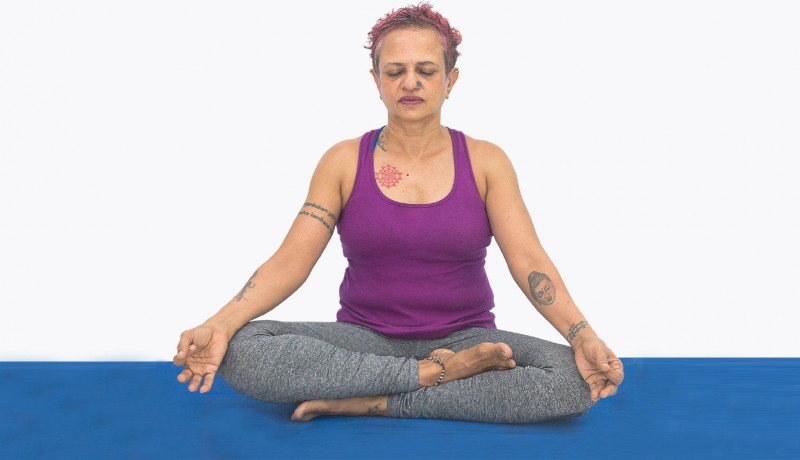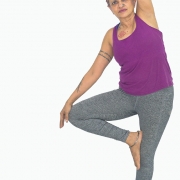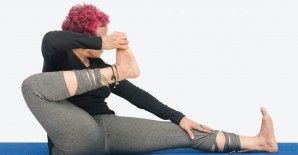
Columns

Shameem Akhtar suggests balancing poses to tackle vertigo
Vertigo is not an exotic disease afflicting a few. In fact, it is getting more common these days and afflicts different age groups, including the very young. In some people, it is diagnosed as benign while among those with more drastic symptoms, it is treated aggressively with medication. It has a cluster of symptoms, from mild dizziness to excessive disorientation, including nausea. In its worst case, it can limit normal life, with patients often advised against driving.
The problem with vertigo is that it has a number of causes, not necessarily related, such as cervical spondylosis, inner ear issues and low blood sugar, among others. So while conventional medication can deal with the symptoms, one needs to dig into the causes to really weed out the problem. It’s important that the medical expert you consult spoors the cause. Also, while balance becomes a real issue with vertigo, yogic poses actually help by retraining the kinesthetic intelligence back into the body. So though you can avoid extreme poses, especially when you have an aggressive attack, you need to continue with some gentle yoga exercises to keep the body engaged in movement so that it does not become fearful. Balancing poses, not surprisingly, work best in this direction.
In vertigo, you need to do grounding poses that help remove anxiety from the body. Standing poses are best. The simple mountain pose (tadasana) and single-legged prayer pose (ekapadapranamasana), also called the single-legged tree pose (ekapadavrksasana), are great. They have several variations if you feel the need to spice up your practice. Single-legged standing poses, with different degrees of challenges, may be incorporated in a phased manner. These include the crescent pose (ardhachandrasana) and its variations and the warrior pose (virabhadrasana) and its entire series.
In extreme cases of vertigo, in the initial stage, you can avoid standing forward bends, such as the extreme stretch (uttanasana), and lying chest-openers, like the fish (matsyasana). Twists, too, need to be modified, especially for those who suffer vertigo owing to neck problems as these will aggravate the symptoms. Grounding and balancing pranayamas like alternate nostril breathing (anulom vilom) with a modified ratio of inhalation-exhalation and humming bee (bhramari) must be done to remove anxiety. This is crucial because, in certain cases, the trigger for vertigo may be psychosomatic. The ideal mudra in such ailments is the grounding prithvi (earth) mudra, done by touching the tip of your ring finger to the tip of the thumb (for both hands).
The best complete body workout is the series of energy-releasing practices (pawan muktasana). This can be life-transforming—not just for vertigo but several chronic ailments. The series covers the entire body, encourages lymphatic drainage, and is the best module for any issues related to the nervous system. There are several versions of the pawan muktasana series and some are also available online. Stick to one set for six weeks, and tweak the challenge by introducing variations.
YOGIC MOVES
Wish-fulfilling tree pose (Kalpavrksasana)
Stand straight. Fold your right leg into the half-lotus position (ardha padmasana) as shown, with the leg folded at the knee and ankle placed at the left hip joint. Lift both hands overhead. Let the left hand remain as it is, close to the left ear. Now pass the right palm over the right knee as shown, tilting to the right side. Let the torso remain straight. Keep the left leg also straight. The right hand can be at the right knee, or slide over it. Hold for a few seconds. Repeat for the other side. Breathe normally throughout.
Benefits: This pose improves balance and grounds you mentally. It works the side body, gently removing fat on the waist (if held for long) and tones the legs and arms.
KNOW YOUR KRIYA
Humming bee breathing practice (Bhramari pranayama)
Sit in a cross-legged position with your hands in the prithvi (earth) mudra and eyes shut. Inhale and exhale deeply a few times. As you inhale, make a humming sound. And as you exhale, again make a humming sound. In between the inhalation and exhalation, there will be a natural gap/ breath retention—do not force it; it happens on its own and thus does not stress the body. This is one round. Do up to six rounds. In case the process is difficult during inhalation, stick to the basic version of making the humming sound only during exhalation.
Shameem Akthar is a Mumbai-based yoga acharya. If you have any queries for her, mail us or email at contact.us@harmonyindia.org. (Please consult your physician before following the advice given here)
Photos: Haresh Patel Featured in Harmony — Celebrate Age Magazine August 2018
you may also like to read
-
Mental workout
Mukul Sharma tells you how to keep those grey cells ticking Everyone will ultimately lose his or her brain….
-
Helpline
Dr Harshbir Rana answers your queries on personal and social issues related to ageing, elder care and intergenerational relationships ….
-
Off the cuff
Raju Mukherji pays tribute to his first hero, Tenzing Norgay, an exemplary mountaineer Darjeeling, 1955. Dr ‘Pahari’ Guha Mazumdar….
-
Yoga RX
Shameem Akthar shows ways to control debilitating ankle pain through regular practice Ankle pain is so common and prevalent….








